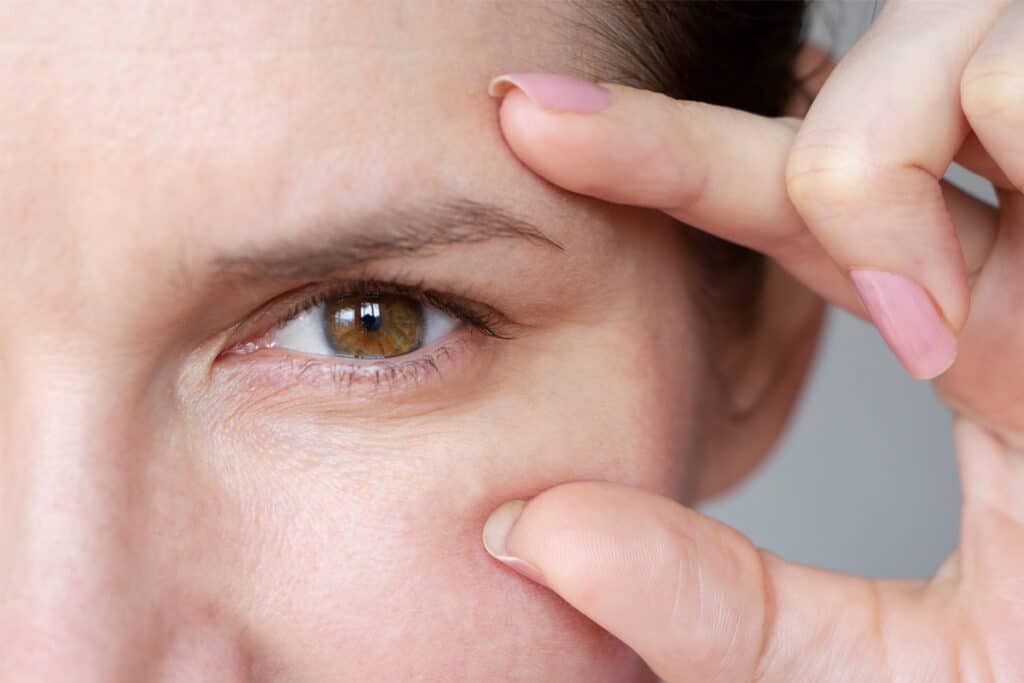Correcting a previous eyelid surgery is a process that requires careful thought and expert advice. Dr. Joanna Kam has significant experience in the area, providing valuable information for people wanting to improve the results of an earlier operation. From the first evaluation to the final stages of healing, it’s essential to follow a well-planned path.
Those who are not happy with their past surgery outcomes have opportunities for improvement. An experienced surgeon can help you understand the possible methods of correction, the risks involved, and the importance of following a strict routine after the surgery to help you get the results you want.

Fixing Your Eyelid Surgery
- Reversing a previous eyelid surgery requires a tailored approach, often involving corrective procedures.
- Finding a skilled surgeon with experience in revision eyelid surgeries is crucial for the best outcome.
- Recovery time after eyelid surgery correction varies, but patients should prepare for a similar downtime as the initial surgery.
- The cost of reversing eyelid surgery depends on the complexity of the correction needed.
- Non-surgical options like fillers may also help improve the appearance after a previous eyelid surgery but have limitations.
Understanding Eyelid Surgery Revision
The Need for Revision
Individuals may consider a revision procedure if the results of a previous eyelid surgery did not meet their expectations. Sometimes, an initial surgery leads to complications or results in an appearance that is not satisfactory. Issues may include asymmetry or functional challenges like vision problems from too much or too little correction. Such outcomes, though disheartening, can often be remedied.
What a Revision Can Achieve
It is intended to correct specific issues arising from a botched eyelid surgery. The goal of corrective eyelid surgery is to enhance both aesthetics and functionality, addressing concerns such as scarring, unusual eyelid shapes, or general dissatisfaction with the outcome of a disappointing surgery. These procedures are meticulously planned to preserve the delicate eyelid structure and to boost the patient’s confidence and satisfaction with their appearance.
1. Assess the Reason for Dissatisfaction
Identifying Specific Issues
When patients are not content with their original eyelid surgery, pinpointing the exact issues is critical. These may include:
- The common issue of how much skin was removed impacts the eyes’ functionality and aesthetics.
- Adjustments to the muscles in the eyelids lead to upper eyelid issues, significantly affecting facial appearance and symmetry.
- Contour issues are presented as unnatural shapes or angles disrupting the face’s harmony.
The precision required in blepharoplasty highlights that even minimal alterations can result in significant changes.
Understanding Limitations
Patients need to have realistic expectations for surgery:
- Acknowledge that not all severe issues can be completely resolved.
- Understand the realistic outcomes of revision surgery and what cosmetic eyelid surgery results can feasibly achieve.
- Recognize the inherent limitations of surgeries, including the possibility of enduring some imperfections.
The goal is for patients to consider what could be improved from the previous blepharoplasty and align their expectations for surgery with what it can realistically accomplish.
2. Consult with a Specialist
Choosing the Right Surgeon
When looking for a skilled eyelid surgeon, your choice can greatly affect the results of revising a prior eyelid surgery. Seek a facial plastic surgeon who not only focuses on eyelid surgeries but has a good history with successful outcomes. They must have thorough training in eyelid surgery and are adept with revisional surgery techniques.
Preparing for Your Consultation
To get ready for your consultation, gather all necessary medical documents, including records of previous surgeries. Note down any issues you faced with earlier surgeries, which will be crucial for the surgeon to know.
Compile questions you want to ask, such as the surgeon’s experience, the unique challenges they expect with your case, and how they plan to reach the desired aesthetic results. A well-prepared consultation helps make the conversation with your surgeon more effective, allowing you to make a well-informed decision about their suitability for your needs.
3. Review Potential Options
Non-Surgical Interventions
To further enhance previous eyelid procedures, consider the following non-surgical options:
- Fillers: They can add volume and smooth out minor irregularities.
- Laser Resurfacing: This technique can improve skin texture and promote a more youthful appearance.
- Chemical Peels: These treatments can address skin surface issues, aiding in the rejuvenation of the eyelid area.
These non-surgical interventions are typically preferred due to their shorter recovery times and lower associated risks, making them a practical choice when additional surgery is not deemed necessary.
Surgical Revisions
The reasons for considering eyelid revision surgery include:
- To address significant concerns such as scarring or asymmetry.
- To undertake complex revision surgery that may involve intricate work and comes with higher potential risks, as well as possibly necessitating a longer recovery period.
Consulting with an experienced plastic surgeon is vital to understanding the anticipated benefits and potential risks associated with these surgeries — whether the aim is cosmetic improvement or reconstructive surgery.

4. Understand the Risks and Recovery
Potential Complications
Cosmetic eyelid surgery, like all surgeries, comes with potential complications such as:
- Controllable discomfort after surgery with standard pain relief.
- Infection after surgery may alter results.
- Persistent swelling after surgery can affect the aesthetic outcome.
- Unpredictability is a facet of any complex surgery, especially in revisional surgeries and more complicated revision surgeries due to altered anatomy and scar tissue.
Expected Recovery Timeline
- Preparation: Occurs in the hours before surgery.
- Immediate Post-Surgery: Monitoring is critical, with an emphasis on rest and the use of cold compresses to address swelling.
- First Few Weeks: Bruising and swelling after surgery are normal and improve gradually.
- Activity Resumption: Most return to their usual activities after 10 to 14 days.
- Long-Term Recovery: Full healing and the true outcome of surgery may take months.
Following the surgeon’s recommendations is crucial for managing unpredictable elements of surgery and achieving the best recovery. Recovery is subjective, and your surgeon will provide personalized advice.
5. Make a Well-Informed Decision
When considering revisional eyelid surgery, it’s vital to weigh the benefits and potential risks to make a well-informed decision.
Pros:
- Addresses irregularities from primary surgery
- It can lead to better vision
- Improves cosmetic appearance
- Resolves discomfort from the initial procedure
- Aims to restore eyelid shape
Cons:
- More complex than primary surgery
- New risks may be introduced
- The healing process might be less predictable post-primary surgery
Discussion with a surgeon can clarify the expected outcome of revision surgery, including any long-term commitments and management of expectations.
6. Prepare for the Revision Procedure
Pre-Operative Requirements
Please follow these guidelines before your revision procedure to ensure everything goes smoothly:
- Medical Background Review: Your surgeon will review your medical history and the healing of tissues since your initial eyelid procedure.
- Personalized Care Plan: The care approach may involve using prescribed ointments or performing recommended exercises.
- Medication and Substance Guidelines: You will be advised to avoid medications and substances that could impact the surgery or recovery process.
What to Expect on the Day of Surgery
Here are key points to understand for the day your type of procedure is carried out:
- Transportation Arrangements: Have a trusted person organize your transportation home as you won’t be fit to drive post-anesthesia.
- Surgery Insights: The surgeon will use information from your initial procedure to meticulously plan the revision.
- Procedure Steps: Each aspect, including anesthesia administration and incision closure, will be carefully executed.
- Monitoring: Medical staff will closely monitor your vital signs and provide comfort throughout the process.
Post-Operative Care
Post-surgery, it’s essential to adhere to the following instructions:
- Apply any prescribed ointments as part of supportive eyelid care.
- Attend all scheduled post-operative appointments to monitor healing and progress.
Step 7: Follow Proper Post-Operative Care
Immediate Aftercare Instructions
After a revision blepharoplasty procedure, adhering to post-operative care instructions is crucial for proper healing:
- Use cold compresses to reduce swelling.
- Take prescribed medications to alleviate discomfort.
- Rest adequately, abstaining from intense activities such as sailing after surgery until cleared by the healthcare provider.
Long-Term Care for Optimal Results
Sustaining the outcome of this surgical procedure also involves consistent long-term care:
- Protect your eyes from sunlight exposure.
- Regularly use eye drops for comfort.
- Attend continued check-ups with the surgeon.
- Follow tailored aftercare directions, especially if the procedure includes a form of ptosis surgery.
Each patient’s recovery is unique, so individuals should monitor their progress and immediately address any concerns with their surgeon. This guidance is designed to support a smooth and favorable healing process, maintaining the results over time.
When to Seek Further Medical Advice
Post-surgery, it’s crucial to look out for and respond to any concerning signs:
- Unusual Symptoms: If something unexpected occurs.
- Recovery Deviations: When your recovery doesn’t follow the expected course.
- Persistent Pain or Vision Changes: Any ongoing discomfort or alterations in sight.
- Infection Symptoms: Signs of infection such as redness, swelling, or discharge.
- Unimproved Cosmetic Concerns: If the initial cosmetic concern shows no signs of improvement or worsens.
In any of these instances, promptly consulting your surgeon is key to ensuring your recovery is on track.
Achieving Your Desired Outcome
If you’re looking to fix issues from past eyelid surgery, getting help from a pro is key. Dr. Joanna Kam is highly skilled in facial plastic surgery and focuses on what each patient needs. She’s good at making people look their best while also caring about what you want. Dr. Kam is experienced in handling tricky cases and is dedicated to giving you the results that are important to you.
Making an appointment with Dr. Joanna Kam means you’re taking action to make sure your concerns are addressed by someone who knows what they’re doing. With her strong background and focus on caring for her patients, Dr. Kam helps you make smart choices about your treatment. Get in touch with us to begin fixing your past surgery outcomes and feeling confident and happy with how you look.
